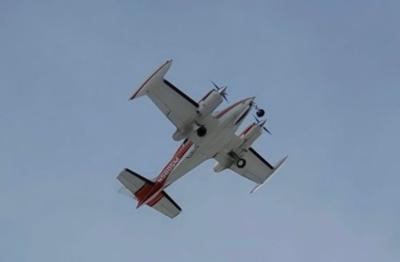Photographically Documented Utah Accident Took Life of Pilot
From The NTSB Preliminary Report: On January 15, 2020, about 1511 mountain standard time, a Cessna T-310P airplane, N5805M, impacted terrain near Roy, Utah, while on approach to Ogden Airport (OGD), Ogden, Utah. The commercial pilot was fatally injured. The airplane was substantially damaged. The airplane was registered to S.A.C. Industries LLC and operated by Goode Ski Technologies as a Title 14 Code of Federal Regulations Part 91 personal flight. Visual meteorological conditions prevailed, and no flight plan was filed for the local flight that originated from Skypark Airport (BTF), Bountiful, Utah, at 1500 and was destined for OGD.

According to OGD air traffic control tower (ATCT) personnel, the pilot checked in with the tower when the airplane was about 9 miles south of OGD. The pilot reported that he was inbound from BTF, and requested a full-stop landing. Subsequently, the controller obtained clearance for the pilot to transition into Hill Air Force Base (HIF) airspace for the approach. About 2 miles from the airport, the pilot reported that he was 2 miles out and the controller cleared the pilot for landing on runway 35. The pilot read back the instruction to the controller. According to the controller, at this point, the communication between the pilot and the controller was reported as normal. The controller used his binoculars to view the airplane and verify that the airplane's landing gear was down for the landing. While viewing the airplane, he saw the airplane initiate a steep left banking turn, followed by a steep bank to the right while losing altitude, after which the controller lost sight of the airplane. A short
inaudible sound was made over the radio. No further communication from the pilot was reported.
Several witnesses reported that they saw the airplane and noticed how slow it seemed to be when it was flying northbound, parallel, over the interstate highway I-15. An eyewitness who was in a store adjacent to the interstate, and about 1-1/2 miles south of OGD, heard the airplane while inside the store and went outside to get a better view. The witness described the sound as "popping," and he thought that one of the engines was trying to be restarted. The witness reported that the airplane was flying northbound above the interstate at about 150 ft to 200 ft above the ground, and that the landing gear and the flaps were extended. A second eyewitness at the same location took a photo as the airplane flew overhead (see above). As the first eyewitness watched the airplane continue to fly north and away from his location, he saw that the airplane was "crabbing" to the left and that it seemed to be struggling to stay airborne. While it was crabbing, he could see the left side of the airplane's fuselage,
and noticed that the tail section seemed to be lower than normal. Subsequently, the airplane's left wing dropped, the airplane momentarily stabilized, and the left wing dropped again, banking the airplane further to the left. The airplane crossed to the other side of the interstate, where the nose dropped, and where he soon lost sight of it.

A forward-facing car dash camera in an automobile driving northwest on a road paralleling the interstate, captured the airplane as it was flying northbound, paralleling the interstate. The airplane was flying away from the camera, appeared to be about 150 ft above the ground, with the wings level and the landing gear extended.
A doorbell surveillance camera captured the airplane in a nose-down, left wing down attitude, about 50 ft above the ground prior to the accident sequence. A fire explosion was visible during the accident sequence from other doorbell cameras in the neighborhood.
Examination of the accident site revealed that the first identified point of contact was the southwest corner of a roof of a townhome complex. The debris field continued at the front yard of the same townhome and along the street. The debris field was about 135 ft long and on a directional heading of about 210 degrees magnetic. The left wing tip tank was found embedded in the roof of the townhome. A 20 ft tall tree near the townhome was damaged and sections were found throughout the debris field. The main wreckage was found along the street where it came to rest upright on a rock retaining wall. The main wreckage had impact and fire damage, with the cabin area mostly consumed by fire. The engines were found separated from their mounts, but remained attached to the airframe by cables and tubing. The wreckage was recovered to a secure facility for further examination.
 ANN's Daily Aero-Term (04.26.24): DETRESFA (Distress Phrase)
ANN's Daily Aero-Term (04.26.24): DETRESFA (Distress Phrase) ANN's Daily Aero-Linx (04.26.24)
ANN's Daily Aero-Linx (04.26.24) Airborne 04.22.24: Rotor X Worsens, Airport Fees 4 FNB?, USMC Drone Pilot
Airborne 04.22.24: Rotor X Worsens, Airport Fees 4 FNB?, USMC Drone Pilot Airborne 04.24.24: INTEGRAL E, Elixir USA, M700 RVSM
Airborne 04.24.24: INTEGRAL E, Elixir USA, M700 RVSM Airborne-NextGen 04.23.24: UAVOS UVH 170, magni650 Engine, World eVTOL Directory
Airborne-NextGen 04.23.24: UAVOS UVH 170, magni650 Engine, World eVTOL Directory




